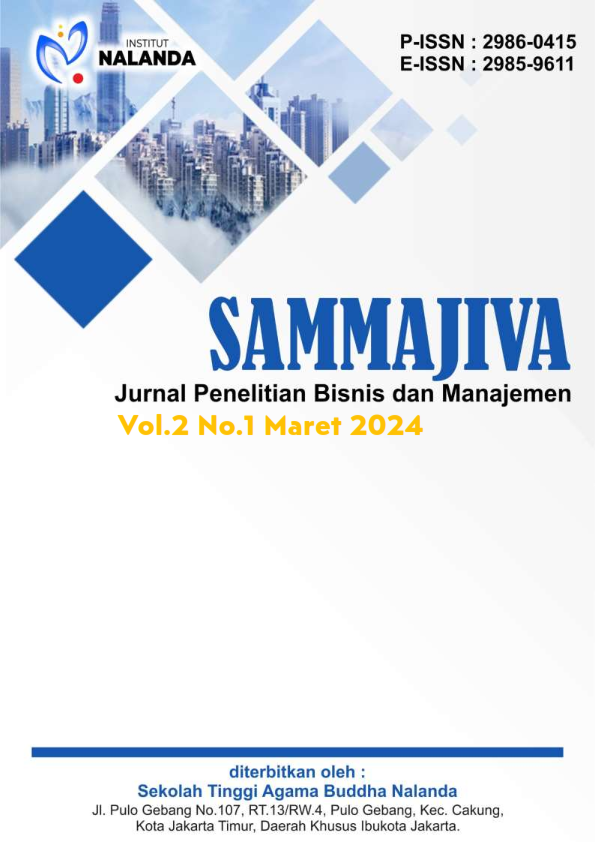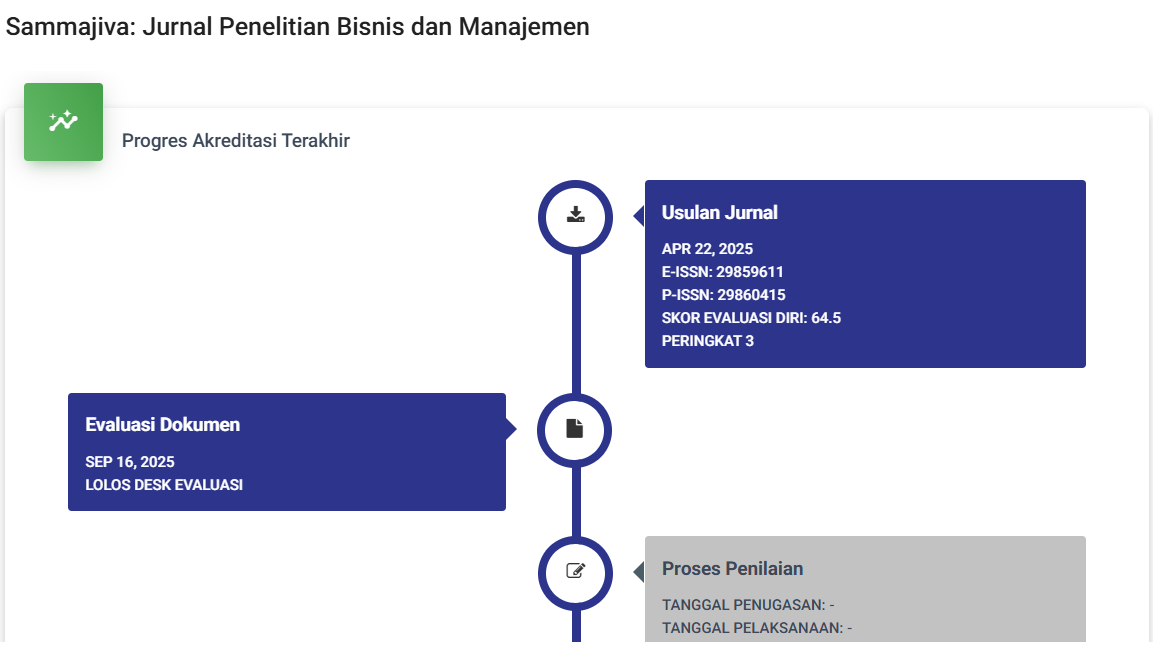Penerapan Algoritma C4.5 untuk Klasifikasi Customer Churn pada Perusahaan Perbankan
DOI:
https://doi.org/10.47861/sammajiva.v2i1.808Keywords:
C4.5 Algorithm, Customer Churn, Decision TreeAbstract
In the fast-paced digital era, companies must continue to innovate to survive. Especially in banks, retaining customers is the main strategy to be able to project business continuity. The topic of customer retention pays more attention to studying customer patterns that have a tendency to survive. This is very difficult to do because the observed data is generally very complex and amounts to a very large amount. Therefore, computers are a technology that is very suitable to solve these problems. Decision tree is a method that is currently being widely used for research. Moreover, with various versions that continue to be developed such as the C4.5 algorithm, it is a guarantee that this algorithm is still relevant for use in today's industry. Even so, there is still no customer retention prediction research with banking industry case studies. The results of this research test, prove that using the C4.5 algorithm, successfully predict customer churn with an accuracy of 99.77%.
References
Alkitbi, S. S., Alshurideh, M., Al Kurdi, B., & Salloum, S. A. (2021). Factors Affect Customer Retention: A Systematic Review (pp. 656–667). https://doi.org/10.1007/978-3-030-58669-0_59
AL-Shatnwai, A. M., & Faris, M. (2020). Predicting Customer Retention using XGBoost and Balancing Methods. International Journal of Advanced Computer Science and Applications, 11(7). https://doi.org/10.14569/IJACSA.2020.0110785
Anees, R. T., Nordin, N. A., Anjum, T., Cavaliere, L. P. L., & Heidler, P. (2020). Evaluating the Impact of Customer Relationship Management (CRM) Strategies on Customer Retention (A Study of Fast Food Chains in Pakistan). Business Management and Strategy, 11(2), 117. https://doi.org/10.5296/bms.v11i2.17934
Apriliyawan, B., & Lestari, S. (n.d.). Performance Analysis Of C4.5 And Naïve Bayes Algorithm On Customer Relationship Management (CRM) In Jatimas Furniture Ltd.
Desena Damanik, S., & Ihsan Jambak, M. (2023). Klasifikasi Customer Churn pada Telekomunikasi Industri Untuk Retensi Pelanggan Menggunakan Algoritma C4.5. Kajian Ilmiah Informatika Dan Komputer, 3(6), 1303–1309. https://doi.org/10.30865/klik.v3i6.829
Gu, Y., Palaoag, T. D., & Dela Cruz, J. S. (2021). Comparison of Main Algorithms in Big Data Analysis of Telecom Customer Retention. IOP Conference Series: Materials Science and Engineering, 1077(1), 012045. https://doi.org/10.1088/1757-899X/1077/1/012045
Höppner, S., Stripling, E., Baesens, B., Broucke, S. vanden, & Verdonck, T. (2020). Profit driven decision trees for churn prediction. European Journal of Operational Research, 284(3), 920–933. https://doi.org/10.1016/j.ejor.2018.11.072
Kassem, E. A. el, Ali, S., Mostafa, A., & Kamal, F. (2020). Customer Churn Prediction Model and Identifying Features to Increase Customer Retention based on User Generated Content. International Journal of Advanced Computer Science and Applications, 11(5). https://doi.org/10.14569/IJACSA.2020.0110567
Kelvin, Cindy, Charles, Peter Leonardo, D., & Yennimar. (2020). Customer Churn’s Analysis In Telecomunications Company Using Fp-Growth Algorithm. Jurnal Mantik, 4(2), 1285–1291. https://doi.org/https://doi.org/10.35335/mantik.Vol4.2020.933.pp1285-1290
Kim, S., & Lee, H. (2022). Customer Churn Prediction in Influencer Commerce: An Application of Decision Trees. Procedia Computer Science, 199, 1332–1339. https://doi.org/10.1016/j.procs.2022.01.169
Larsson, A., & Broström, E. (2020). Ensuring customer retention: insurers’ perception of customer loyalty. Marketing Intelligence & Planning, 38(2), 151–166. https://doi.org/10.1108/MIP-02-2019-0106
Miryam Clementine, & Arum. (2022). Prediksi Churn Nasabah Bank Menggunakan Klasifikasi Naïve Bayes dan ID3. Jurnal Processor, 17(1), 9–18. https://doi.org/10.33998/processor.2022.17.1.1170
Muttaqien, R., Galih, M., & Pramuntadi, A. (2021). Implementation of Data Mining Using C4.5 Algorithm for Predicting Customer Loyalty of PT. Pegadaian (Persero) Pati Area Office. In International Journal of Computer and Information System (IJCIS) Peer Reviewed-International Journal (Vol. 02, Issue 03). https://ijcis.net/index.php/ijcis/indexJournalIJCIShomepage-https://ijcis.net/index.php/ijcis/index
NGUYEN, D. T., PHAM, V. T., TRAN, D. M., & PHAM, D. B. T. (2020). Impact of Service Quality, Customer Satisfaction and Switching Costs on Customer Loyalty. The Journal of Asian Finance, Economics and Business, 7(8), 395–405. https://doi.org/10.13106/jafeb.2020.vol7.no8.395
Harahap, N. H. S., Amirullah, A., Saputro, M. B., & Tamaroh, I. A. (2022). Classification of potential customers using C4.5 and k-means algorithms to determine customer service priorities to maintain loyalty. Journal of Soft Computing Exploration, 3(2). https://doi.org/10.52465/joscex.v3i2.89
Saleh, S., & Saha, S. (2023). Customer retention and churn prediction in the telecommunication industry: a case study on a Danish university. SN Applied Sciences, 5(7), 173. https://doi.org/10.1007/s42452-023-05389-6
Simanjuntak, M., Putri, N. E., Yuliati, L. N., & Sabri, M. F. (2020). Enhancing customer retention using customer relationship management approach in car loan bussiness. Cogent Business & Management, 7(1), 1738200. https://doi.org/10.1080/23311975.2020.1738200
Sinaga, T. H., Wanto, A., Gunawan, I., Sumarno, S., & Nasution, Z. M. (2021). Implementation of Data Mining Using C4.5 Algorithm on Customer Satisfaction in Tirta Lihou PDAM. Journal of Computer Networks, Architecture, and High-Performance Computing, 3(1), 9–20. https://doi.org/10.47709/cnahpc.v3i1.923
Slack, N., Singh, G., & Sharma, S. (2020). The effect of supermarket service quality dimensions and customer satisfaction on customer loyalty and disloyalty dimensions. International Journal of Quality and Service Sciences, 12(3), 297–318. https://doi.org/10.1108/IJQSS-10-2019-0114
Suhanda, Y., Nurlaela, L., Kurniati, I., Dharmalau, A., & Rosita, I. (2022). Predictive Analysis of Customer Retention Using the Random Forest Algorithm. TIERS Information Technology Journal, 3(1), 35–47. https://doi.org/10.38043/tiers.v3i1.3616








